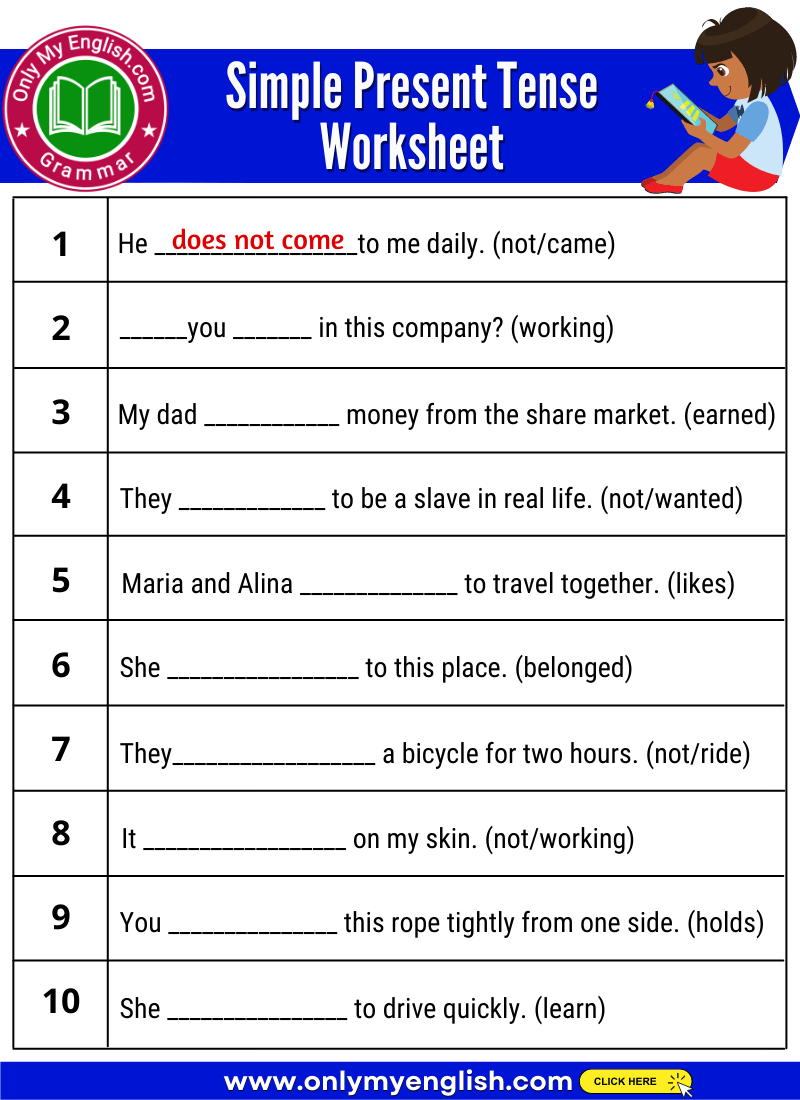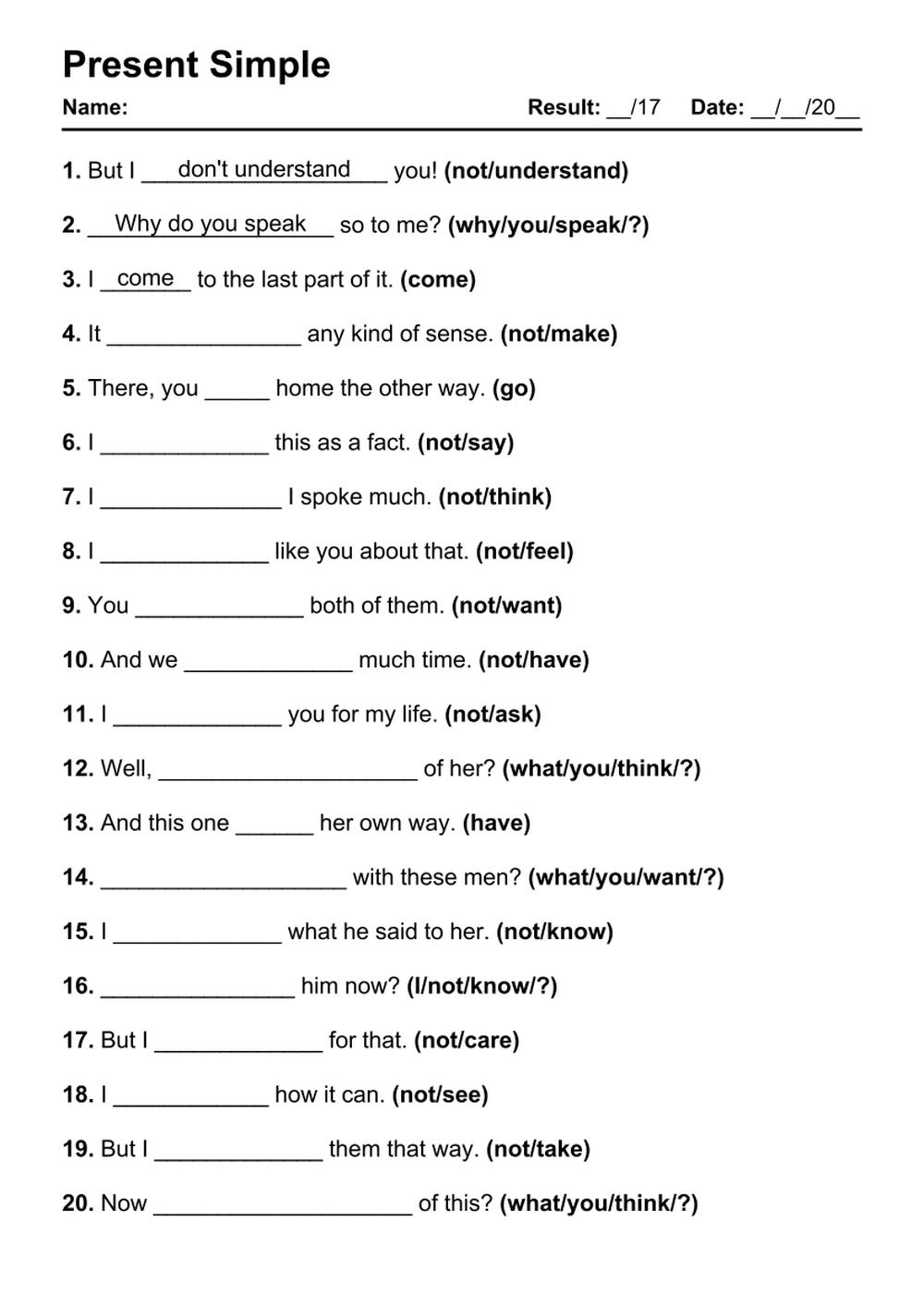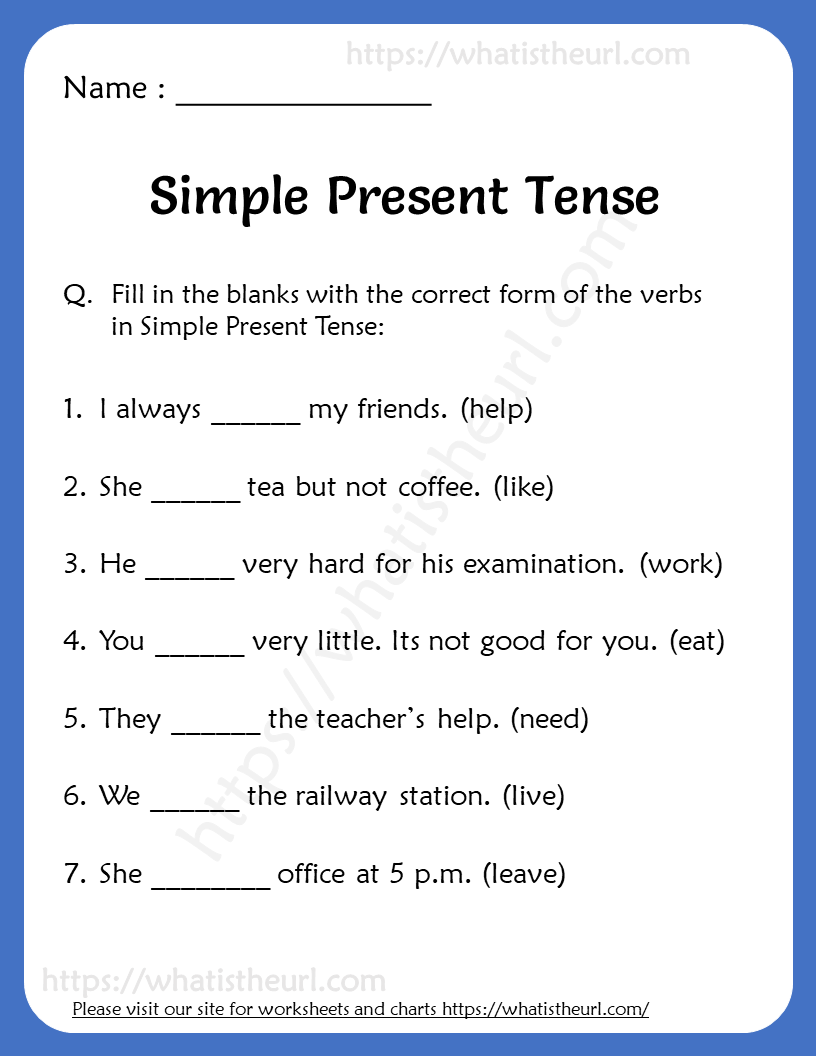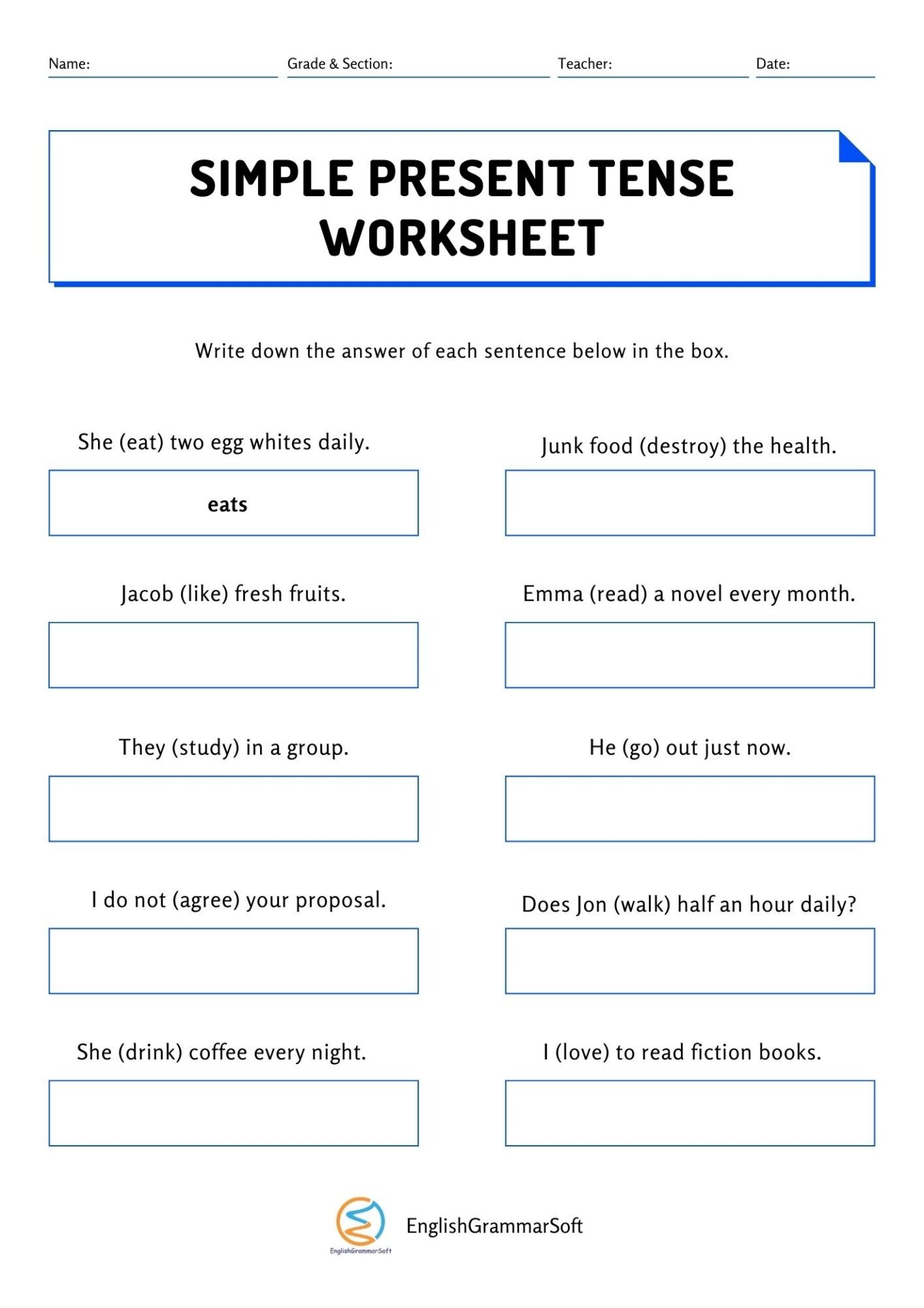
The Indispensable Tool: Mastering Grammar Worksheets: Present Simple Tense
In the intricate tapestry of language learning, grammar serves as the foundational thread that holds everything together. Without a solid grasp of grammatical structures, communication remains fragmented and often misunderstood. Among the myriad of grammatical concepts, the Present Simple Tense stands out as one of the most fundamental and frequently used, forming the bedrock for expressing daily routines, facts, habits, and general truths. While theoretical explanations are crucial, the true mastery of this tense, like any other grammatical structure, comes through consistent and deliberate practice. This is where well-designed Grammar Worksheets: Present Simple Tense prove to be an indispensable tool for both educators and learners.
This article will delve deep into the significance, design, and effective utilization of Grammar Worksheets: Present Simple Tense, exploring why they are far more than just repetitive exercises, but rather dynamic instruments that foster understanding, build confidence, and pave the way for fluent and accurate communication.
The Cornerstone: Understanding the Present Simple Tense

Before exploring the worksheets themselves, it’s vital to briefly revisit the core functions and forms of the Present Simple Tense. This tense is deceptively simple, yet often a source of common errors for learners, particularly regarding the third-person singular "s" and the use of auxiliary verbs "do/does."

Primary Uses:

- Habits and Routines: Actions that happen regularly. (e.g., I wake up at 7 AM every day.)
- Facts and General Truths: Statements that are always true. (e.g., The sun rises in the east.)
- Schedules and Timetables: Fixed future events. (e.g., The train leaves at 9:00.)
- States and Opinions: Verbs of perception, emotion, and possession. (e.g., She loves chocolate. He has a new car.)
- Instructions and Directions: (e.g., First, you mix the ingredients.)



Basic Forms:
- Affirmative:
- Subject + Base Verb (I, You, We, They) – I work, You play.
- Subject + Base Verb + -s/-es (He, She, It) – He works, She plays.


- Negative:
- Subject + do not (don’t) + Base Verb (I, You, We, They) – I don’t work, You don’t play.
- Subject + does not (doesn’t) + Base Verb (He, She, It) – He doesn’t work, She doesn’t play.
- Interrogative (Questions):
- Do + Subject + Base Verb? (I, You, We, They) – Do you work? Do they play?
- Does + Subject + Base Verb? (He, She, It) – Does he work? Does she play?

Understanding these nuances is the first step; applying them accurately and consistently is where Grammar Worksheets: Present Simple Tense become invaluable.
Why Grammar Worksheets are Essential Learning Tools
In an age dominated by interactive apps and digital learning platforms, some might question the continued relevance of traditional worksheets. However, their pedagogical value remains undiminished, especially for foundational grammar.
-
Active Engagement and Reinforcement: Worksheets demand active participation. Learners are not passively listening or reading; they are actively recalling rules, making choices, and applying knowledge. This hands-on approach solidifies understanding and helps internalize the grammar rules. Repetition through varied exercises helps move knowledge from short-term to long-term memory.
-
Identification of Weak Points: As learners complete exercises, patterns of errors often emerge. For teachers, this provides immediate diagnostic information, highlighting specific areas where a student is struggling (e.g., consistently forgetting the ‘s’ for third-person singular, or misusing ‘do’ vs. ‘does’). For learners, self-correction (with an answer key) fosters self-awareness of their own common mistakes.
-
Building Confidence: Successfully completing exercises, especially those with increasing difficulty, builds confidence. It provides tangible evidence of progress, which is a powerful motivator in language acquisition.
-
Structured Practice: Worksheets offer a controlled environment for practice. They isolate specific grammatical structures, allowing learners to focus solely on the Present Simple Tense without being overwhelmed by other complexities. This structured approach is crucial for beginners.
-
Differentiation: Worksheets can be easily adapted to different proficiency levels. Simpler exercises can be given to beginners, while more complex tasks (e.g., error correction, sentence transformation, contextualized writing) can challenge intermediate learners.
-
Assessment and Progress Tracking: For educators, worksheets serve as quick, low-stakes assessment tools. They provide a snapshot of a student’s current understanding and help track progress over time.
-
Portability and Accessibility: Unlike digital tools that require devices and internet access, a physical worksheet is always ready. It can be used anywhere, at any time, promoting independent study.
Designing Effective Grammar Worksheets: Present Simple Tense
The effectiveness of a worksheet lies in its design. A good Grammar Worksheets: Present Simple Tense is not just a collection of fill-in-the-blanks; it’s a thoughtfully constructed learning journey.
A. Variety of Exercise Types:
To prevent boredom and cater to different learning styles, incorporate a range of exercise formats:
- Conjugation Drills (Fill-in-the-blanks): The most common type. Learners fill in the correct form of the verb.
- Example: I (live) in London. She (study) English.
- Sentence Transformation:
- Positive to Negative/Interrogative: Learners rewrite sentences in different forms.
- Example: He plays tennis. (Negative) -> He doesn’t play tennis.
- Using different subjects: Change the subject and adjust the verb form.
- Example: I read books. (Change to ‘She’) -> She reads books.
- Positive to Negative/Interrogative: Learners rewrite sentences in different forms.
- Error Correction: Learners identify and correct grammatical mistakes in sentences. This requires a deeper understanding of the rules.
- Example: He go to school every day. -> He goes to school every day.
- Matching Exercises: Match sentence halves, or match verbs to appropriate nouns/pronouns.
- Example: Match: Column A (She, They, I) to Column B (works, live, plays).
- Short Answer Questions: Learners answer simple questions using the Present Simple.
- Example: What do you do on weekends? Where does your friend work?
- Contextualized Paragraphs/Stories: Learners fill in verbs within a short narrative about routines, facts, or descriptions. This helps them see the tense in a natural context.
- Example: Read about Tom’s day. Fill in the blanks. Tom (wake up) at 6 AM. He (eat) breakfast, then he ___ (go) to work.
- Picture-Based Activities: Use images to prompt sentence creation or descriptions using the Present Simple.
- Example: Show a picture of a person doing an activity and ask, "What does she do every morning?"
- True/False Statements: Learners determine if statements are true or false, often related to general knowledge or a short text provided.
- Creative Writing Prompts: Encourage learners to write a short paragraph about their daily routine, a typical day at school, or facts about their country. This moves beyond isolated sentences into productive use.
B. Key Design Principles:
Beyond variety, good design ensures maximum learning impact:
- Clear Instructions: Ambiguous instructions lead to confusion. Ensure they are concise and easy to understand.
- Gradual Difficulty: Start with simpler, controlled exercises and gradually introduce more challenging ones. This builds confidence and prevents discouragement.
- Contextualization: Whenever possible, present sentences within a meaningful context rather than as isolated grammar puzzles. This helps learners connect grammar to real-world communication.
- Relevance and Engagement: Use topics that are relatable and interesting to the target audience. Examples related to daily life, hobbies, or general knowledge tend to be more engaging.
- Clarity and Readability: Use clear fonts, appropriate spacing, and avoid clutter. A well-organized layout is less intimidating and easier to navigate.
- Inclusion of an Answer Key: For self-study or quick checking, an answer key is invaluable. It empowers learners to take ownership of their learning and correct their own mistakes.
- Focus on Common Pitfalls: Design exercises that specifically target common errors, such as the third-person ‘s’, the use of ‘do/does’, and irregular verbs (e.g., ‘have’ becomes ‘has’).
Implementing and Using Grammar Worksheets: Present Simple Tense Effectively
Creating excellent Grammar Worksheets: Present Simple Tense is only half the battle; how they are used significantly impacts their effectiveness.
For Teachers:
- Pre-Teaching and Review: Always ensure the grammatical concept has been clearly explained and demonstrated before assigning a worksheet. Use the worksheet for reinforcement, not initial instruction.
- Strategic Assignment: Decide whether the worksheet is for in-class practice (individual, pair, or group work) or homework. In-class allows for immediate feedback and clarification.
- Pair/Group Work: Encourage collaborative learning. Students can discuss answers, explain their reasoning to each other, and learn from peer correction.
- Feedback and Correction: Don’t just mark answers right or wrong. Provide constructive feedback. Discuss common errors with the whole class. Encourage students to explain why an answer is correct or incorrect.
- Integration with Other Skills: After completing a worksheet, transition to activities that integrate the Present Simple with speaking, listening, or writing. For example, have students interview each other about their routines, or describe a famous person’s daily life.
For Learners:
- Active Engagement: Don’t just rush through. Take time to think about the rules before answering.
- Self-Correction: If an answer key is provided, use it wisely. Don’t just copy corrections; try to understand why your initial answer was wrong.
- Identify Patterns: Pay attention to the types of mistakes you repeatedly make. This self-awareness is crucial for improvement.
- Seek Clarification: If you’re unsure about a rule or an answer, don’t hesitate to ask your teacher or a peer.
- Consistency: Regular, even short, practice sessions are more effective than infrequent, long ones.
Beyond the Worksheet: Integrating and Advancing
While Grammar Worksheets: Present Simple Tense are foundational, they are a means to an end, not the end itself. The ultimate goal is to enable learners to use the Present Simple Tense naturally and accurately in real-world communication.
After consistent practice with worksheets, bridge the gap to freer production through activities such as:
- Role-playing: Create scenarios where learners describe routines (e.g., "A day in the life of a doctor").
- Debates/Discussions: Use the Present Simple to state facts, opinions, and general truths (e.g., "Climate change is real," "Online learning offers flexibility").
- Creative Writing: Encourage writing short stories, descriptions of characters, or factual reports using the tense.
- Digital Tools: Explore interactive online quizzes, grammar games, or digital worksheets that offer immediate feedback and gamification.
- Transition to Complex Tenses: Once the Present Simple is solid, learners can more easily grasp how it contrasts with other tenses like the Present Continuous (for actions happening now) or the Past Simple (for completed actions).
Conclusion
The journey to language fluency is multifaceted, requiring a blend of theoretical knowledge, consistent practice, and meaningful application. For a fundamental building block like the Present Simple Tense, Grammar Worksheets: Present Simple Tense play an indispensable role. They provide the structured, repetitive practice necessary to internalize rules, identify and correct errors, and build the confidence required for effective communication.
Far from being archaic, these worksheets remain a dynamic and versatile tool in the modern language classroom and for independent learners. When thoughtfully designed and effectively utilized, they transform abstract grammatical concepts into tangible skills, laying a robust foundation for learners to confidently express habits, facts, and truths, thereby taking significant strides towards mastering the English language.
